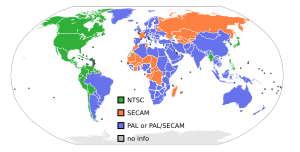NTSC facts for kids
NTSC was an older way that television signals were sent and received. It stands for "National Television System Committee." For many years, NTSC was the main system used for TV in places like North America, Japan, and parts of South America. It was an analog system, which means it used continuous signals, unlike today's digital TVs that use codes of 0s and 1s.
Contents
What was NTSC?
NTSC was a set of rules for how TV signals should be broadcast and displayed. It was developed in the United States in the 1940s and 1950s. The goal was to make sure that TVs from different companies could all show the same broadcast programs. This system helped bring color television to homes for the first time.
How NTSC TV worked
When you watched TV using the NTSC system, the picture was made up of many tiny lines. An NTSC screen typically showed 525 lines of picture, and it refreshed the image about 30 times every second. This quick refresh rate made the moving pictures look smooth to our eyes.
The NTSC system also had a special way of adding color to the black-and-white TV signal. This was important because it meant older black-and-white TVs could still show programs broadcast in color, but they would just see them in black and white. Newer color TVs could then decode the extra information to show the full range of colors.
Where was NTSC used?
NTSC was widely used in many countries around the world. The main places that used NTSC included:
- North America (like the United States, Canada, and Mexico)
- Most of South America
- Japan
- South Korea
- Taiwan
- The Philippines
- Myanmar (also known as Burma)
- Some Pacific island nations and territories
Other parts of the world used different systems, like PAL or SECAM, which worked in slightly different ways.
The end of NTSC
Over time, technology improved, and countries started to switch from analog TV systems like NTSC to digital TV. Digital TV offers a much clearer picture, better sound, and more channels. Most countries that used NTSC have now switched to digital television standards, like ATSC in North America or ISDB-T in Japan and parts of South America. This change meant that older NTSC TVs could no longer receive broadcasts without a special converter box.
Images for kids
See also
 In Spanish: NTSC para niños
In Spanish: NTSC para niños




